Early Arnold Fountain Pens c. 1935-1939
by Jim Mamoulides, November 15, 2024
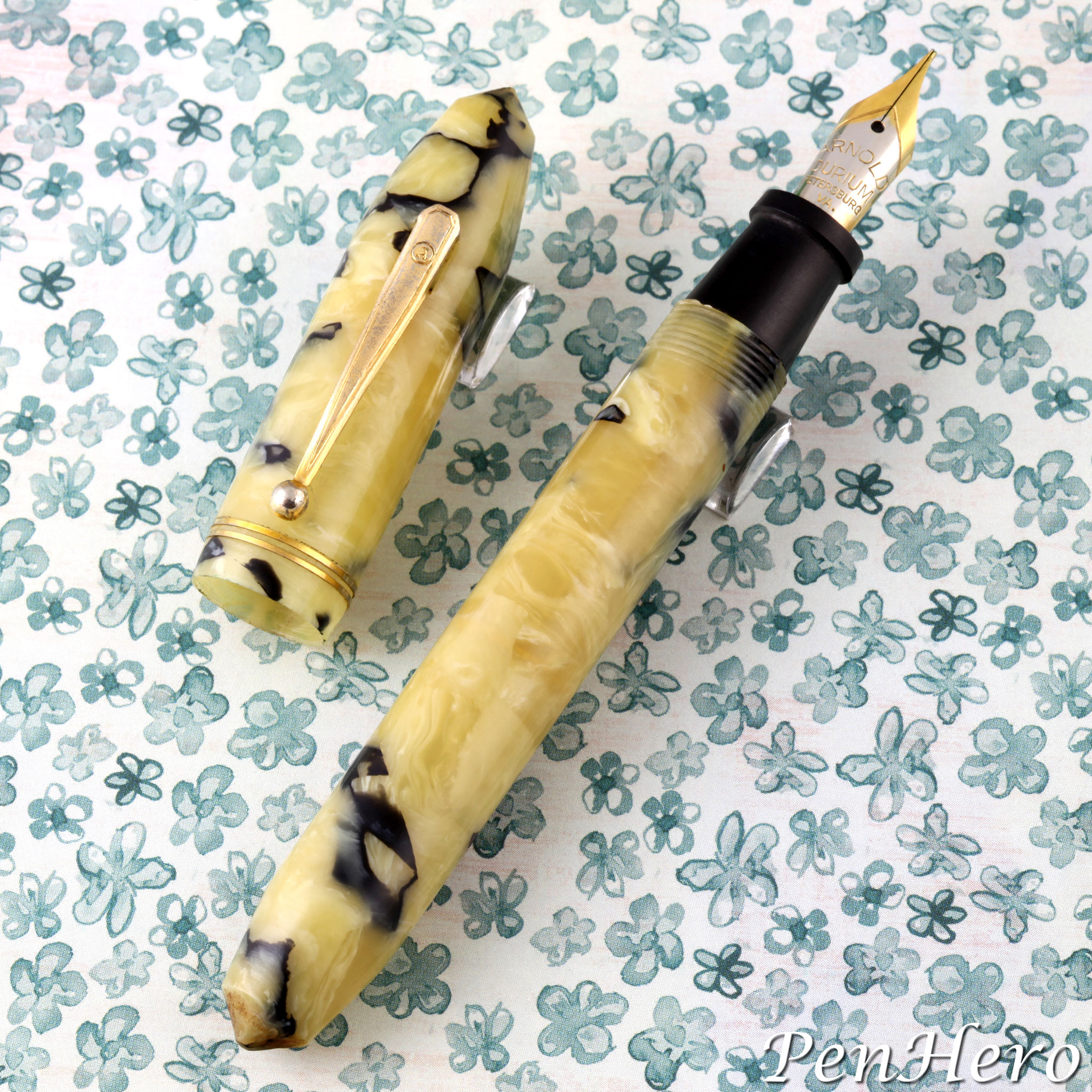 Arnold Jumbo fountain pen in cream and black marbled celluloid c. 1935-1939
Arnold Jumbo fountain pen in cream and black marbled celluloid c. 1935-1939
As Told By Horatio Alger
If Remmie Arnold, founder and owner of the R. L. Arnold Pen Manufacturing Company, was to tell his own life story, I would imagine it would sound a lot like his profile given in Virginia newspapers when he was running for the Democratic nomination for the 1949 Virginia governor’s race. Each telling was like a “Horatio Alger rags to riches story,” as if written by a New York agency. It begins with the birth of Remmie LeRoy Arnold on January 25, 1894, the second of four children of Andrew Alexander Arnold and Mary Virginia Arnold, in Petersburg, Virginia. Petersburg was a small independent city of about twenty-two thousand, not part of any county, about twenty-one miles south of Richmond, which was about four times larger at the time. His father was an unskilled laborer barely covering expenses and to help, Remmie started delivering newspapers at age nine to supplement the family income.
His early life story continues in 1907, when he was “forced to leave school at the age of 12” and went to work as a wood planing mill worker for three dollars a week. Over the next two years “he held jobs as a riveter, stock room clerk in a shoe factory, jewelry repairman, (and) benchman in a trunk factory.” He was then able to get a job as a freight clerk for the Seaboard Air Line Railroad, where he was promoted, and after five years was transferred to the Norfolk and Western Railroad. By the time he was nineteen he saved enough to buy a two room house on three acres of land in Chesterfield County, a county adjoining Petersburg to the west. He soon added two rooms to the house. At twenty years old he set up a grocery store at Stop 46 on the Petersburg end of the Richmond Petersburg Electric Railway, an electric trolley system that began service in 1888, eventually expanding to Petersburg, and ceasing operations in 1949. His father would fill in for him as needed to run the store.
 Arnold fountain pen in black celluloid with blue and yellow streaks c. 1935-1939
Arnold fountain pen in black celluloid with blue and yellow streaks c. 1935-1939
In 1915, Arnold went to work for the recently organized Edison Pen Company of Petersburg (chartered in 1913) and was listed in the Petersburgh City Directory from 1915-1918 as a clerk for the company. He initially repaired pens and sold ink, and later worked assembling them. Arnold worked at Edison for the next twenty years, learning the pen manufacturing business, and rising to be the company’s general manager and president.
Arnold married Charlia Lawrence Sears of Charleston, South Carolina in 1918. They had two children. Their son, Remmie LeRoy Arnold, Jr., graduated with a BS in industrial engineering from Virginia Tech in Blacksburg, Virginia, and joined his father at the Arnold Pen Company, eventually rising to vice president. Their daughter, Dorothy Lawrence Arnold, attended Sweet Briar College, a private women's liberal arts college in Sweet Briar, Amherst County, Virginia, and she married Robert John Waite, who became comptroller at the Arnold Pen Company. The Arnold Pen Company was definitely a family business.
Arnold left the Edison Pen Company in 1935, and the August 8, 1935 Richmond, Virginia News Leader reported the announcement the R. L. Arnold Pen Manufacturing Company was granted a charter of “$50,000 maximum capital” for “a general publishing, printing, bookbinding, and stationary business” in Petersburg, and was to begin operating the next week by August 15. Arnold was then 41 years old.
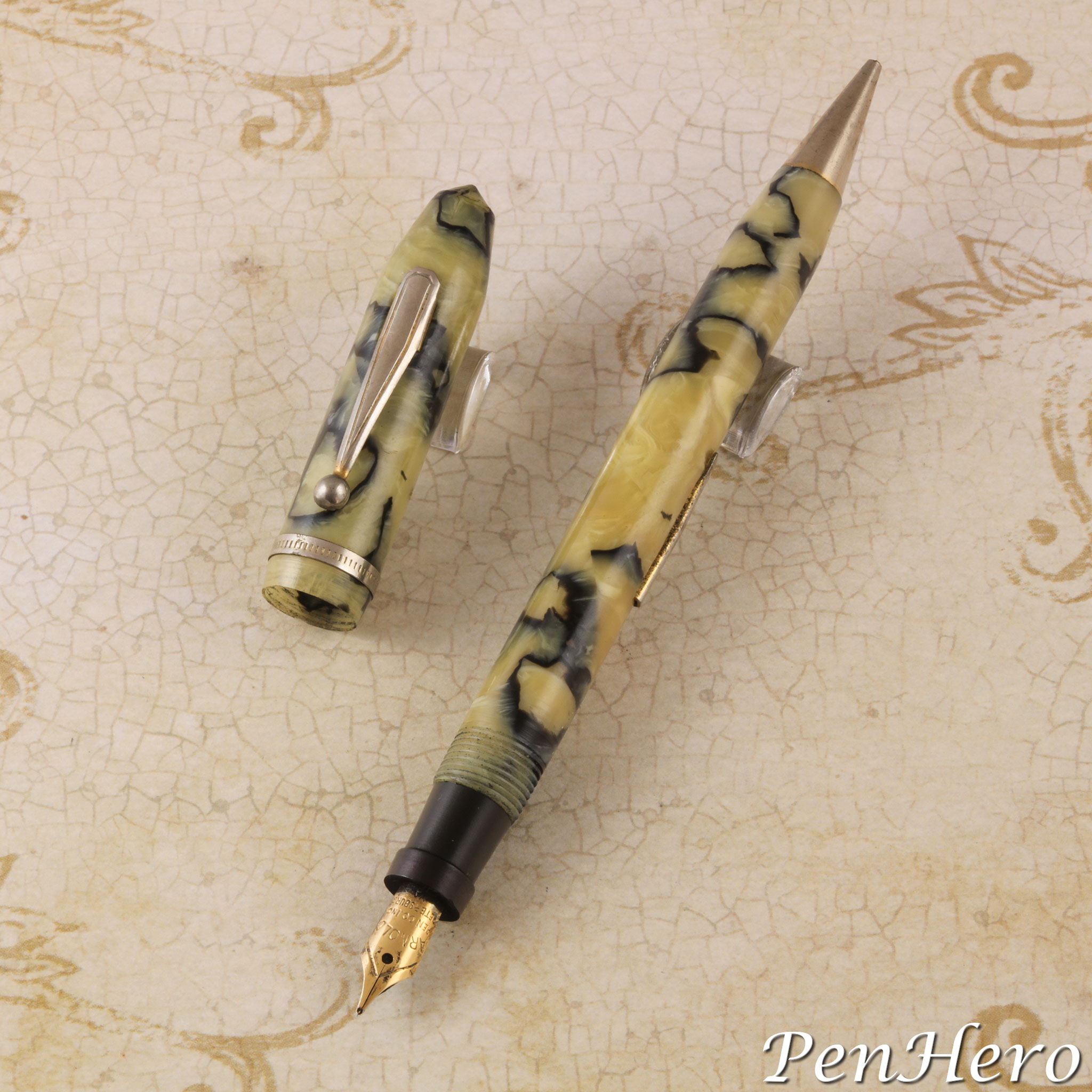 Arnold pen/pencil combo in a spiral wrap cream and black marbled celluloid c. 1935-1939
Arnold pen/pencil combo in a spiral wrap cream and black marbled celluloid c. 1935-1939
After the announcement of the company charter, the new company purchased the Red Fox Pants building at 142 East Washington Street in Petersburg, about a half mile down the street from Edison, at 221 West Washington. Neither building exists today. Because of high interest in the new business and confusion about the charter, Arnold contacted local and regional newspapers, including writing a letter to the Richmond Times-Dispatch, clarifying that his new business was focused only on the manufacture of fountain pens and mechanical pencils. This is because he said, “he had been besieged by salesmen, who, having read the broad terms of the charter, evidently thought he was going into a general printing and bookbinding business.” To set up shop, the company purchased the assets of another fountain pen manufacturer and arranged to have it moved to their new building.
The factory opened with a payroll of fifty people, both men and women, with all the purchased equipment installed and ready for operation on Tuesday, August 19, 1935. In addition, the company would employ twenty-five salesman, planned not only for the United States, but also unspecified “adjoining” foreign countries. The company announced it was commencing production with three hundred orders in hand. Within five years sales and production had increased substantially to where the company employed about 200 people. In addition to fountain pens and pencils, the company also made novelties such as flashlights and keychains. With the company well established, Arnold also became active in the affairs of his home city, serving on the Petersburg city council from 1936 to 1944. Petersburg was about thirty-one thousand in 1940, and Richmond was now about six times larger. As of 1942, the Arnold Pen Company was the second largest manufacturer of pens and pencils in the world, by volume.
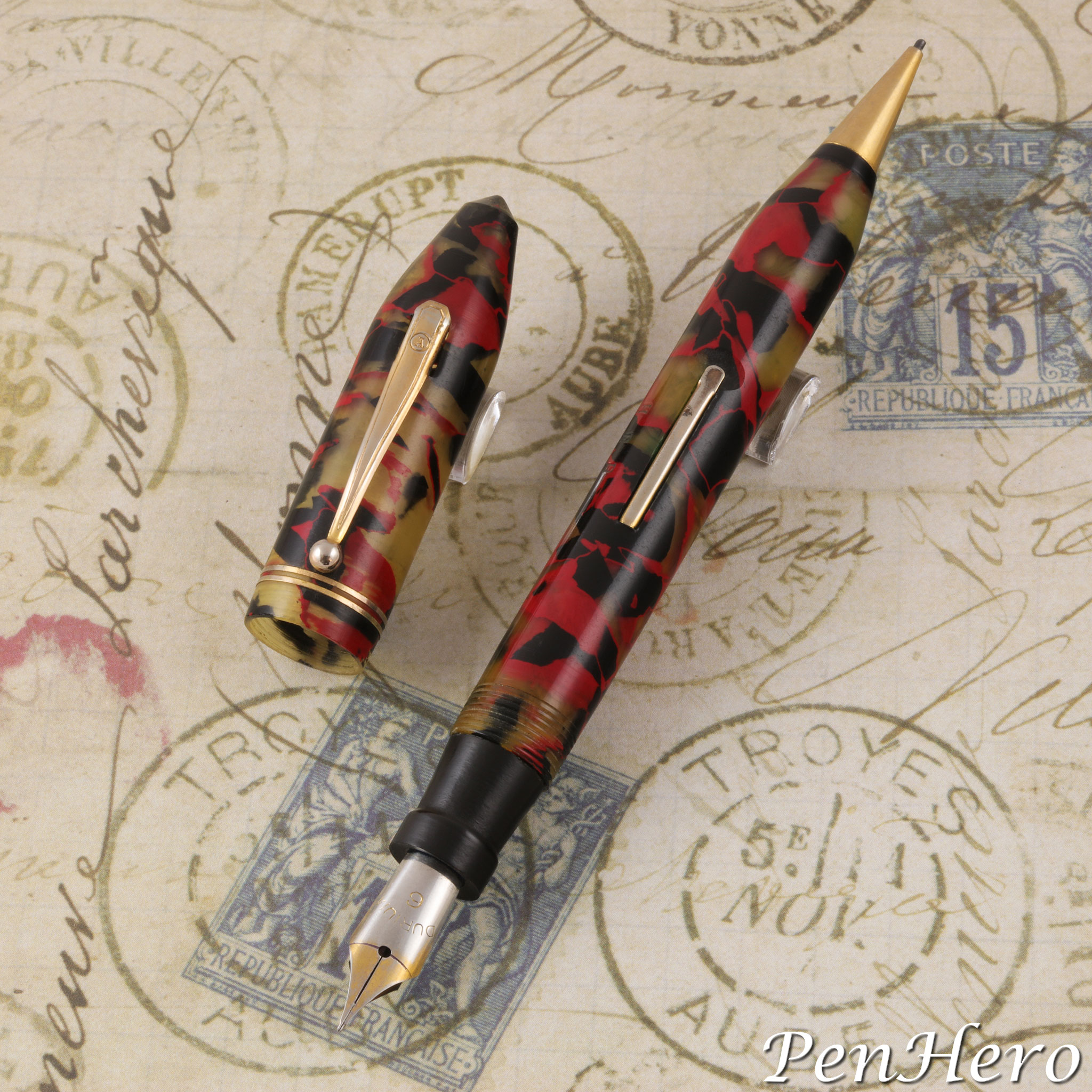 Arnold Jumbo pen/pencil combo in a red and black marbled celluloid c. 1935-1939
Arnold Jumbo pen/pencil combo in a red and black marbled celluloid c. 1935-1939
In early 1942, in response to the war effort, many raw materials used for civilian goods were being embargoed, redirected to wartime use. This included steel, which Remmie Arnold expected, but it would severely impact his pen and pencil making business as steel was used for clips and pen points. Based on his negative personal experience with the people sent to survey his manufacturing plant, Arnold made a direct appeal in March, 1942 to Donald Nelson, head of the War Production Board (WPB), concerned that the people sent did not understand the importance of manufacturing pens and pencils for the war effort nor the ability of the Arnold Pen Company to retool quickly to making wartime goods. Not satisfied with Nelson’s response, over the next two months, expanding his request on behalf of all the manufacturers and businesses in Petersburg, Arnold went to Fred Kimmich, chief of industrial building utilization and then W. H. Wheeler, Jr., contract distribution office at the WPB. Arnold was concerned for morale in the industry and his city.
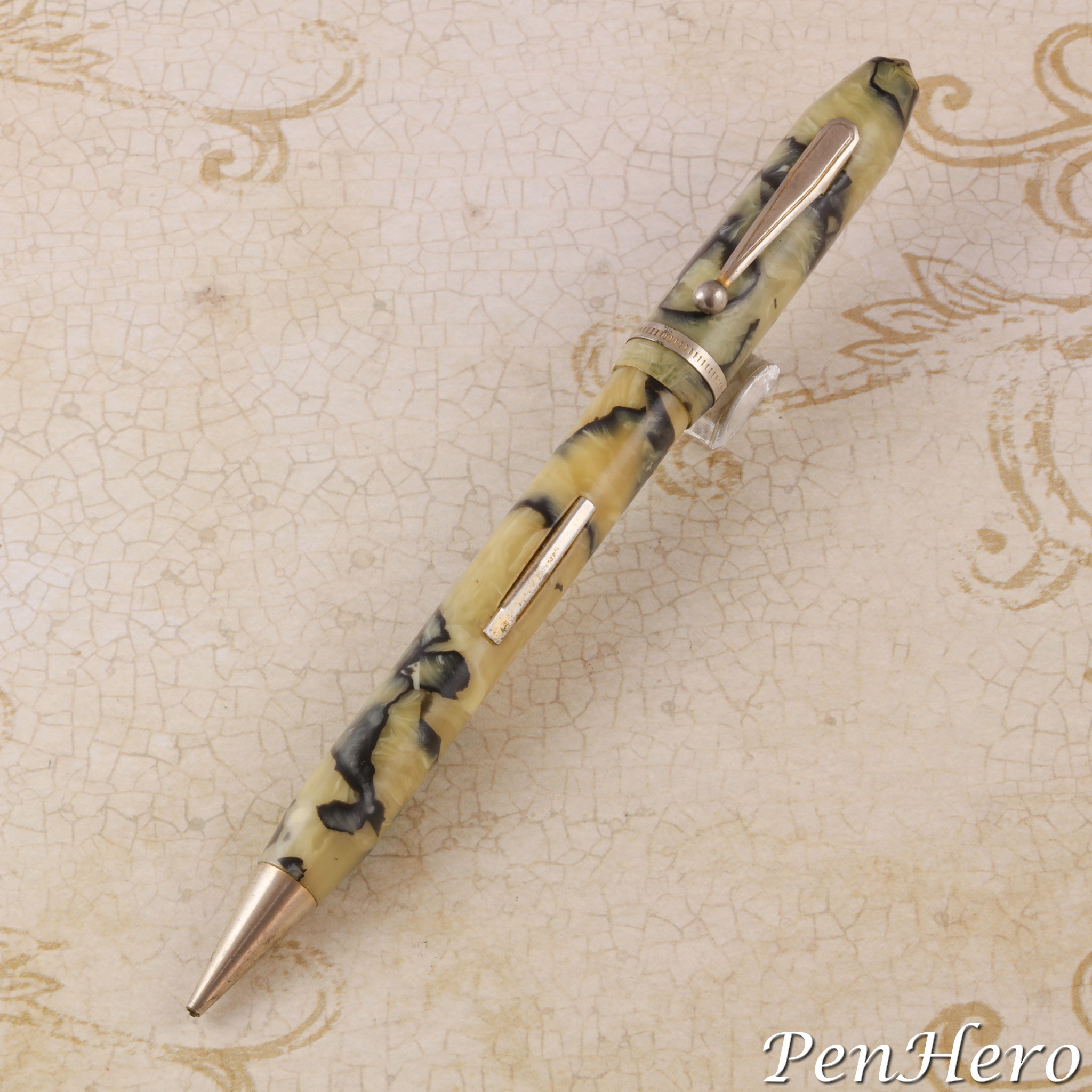 Arnold pen/pencil combo in a spiral wrap cream and black marbled celluloid c. 1935-1939
Arnold pen/pencil combo in a spiral wrap cream and black marbled celluloid c. 1935-1939
Finally, Arnold was notified that Fred Shelor, manager of the WPB in Richmond, would meet with select pen companies to discuss the issue. Arnold was not invited. Undaunted, he decided to press on making pens. At some point the situation must have resolved and Arnold obtained a quota to continue manufacturing pens and pencils because in October, 1944, Arnold was given approval for increased quotas for manufacturing pens and pencils by the WPB.
The company grew and was very successful, making Arnold one of the wealthiest people in Petersburg. In 1945 he bought and renovated Chester Plantation, a large Greek Revival mansion built in the 1840s by Colonel Williamson Simmons, located about twelve miles southeast of Petersburg in the unincorporated community of Disputanta in Prince George County, a county that adjoins Petersburg. He decided to name the large property “Arnolda.” The house has “a two story, full-width porch supported by Doric columns.” Arnold expanded it by adding two flanking 1 ½ story Colonial Revival style wings with three gabled roof dormers in 1949, giving it more than 8,000 square feet of living space, not including several outbuildings. Arnold also added a ten acre lake to the west of the house and a swimming pool. The 738 acre property supported a thoroughbred horse and Aberdeen-Angus cattle farm. The horses were a passion of Arnold’s wife Charlia and were recognized by the Palomino Horse Association and the Tennessee Walking Horse Breeders of America. He also raised some pigs and chickens, as well as some corn.
Arnold ran unsuccessfully for the Democratic party nomination for governor of Virginia in 1949, coming in fourth place out of four, and shelved his political career. He focused on continuing his community service, previously becoming a Mason, and then in 1953 was elected as the first Virginian to hold the title of the imperial potentate of the Shriners in North America.
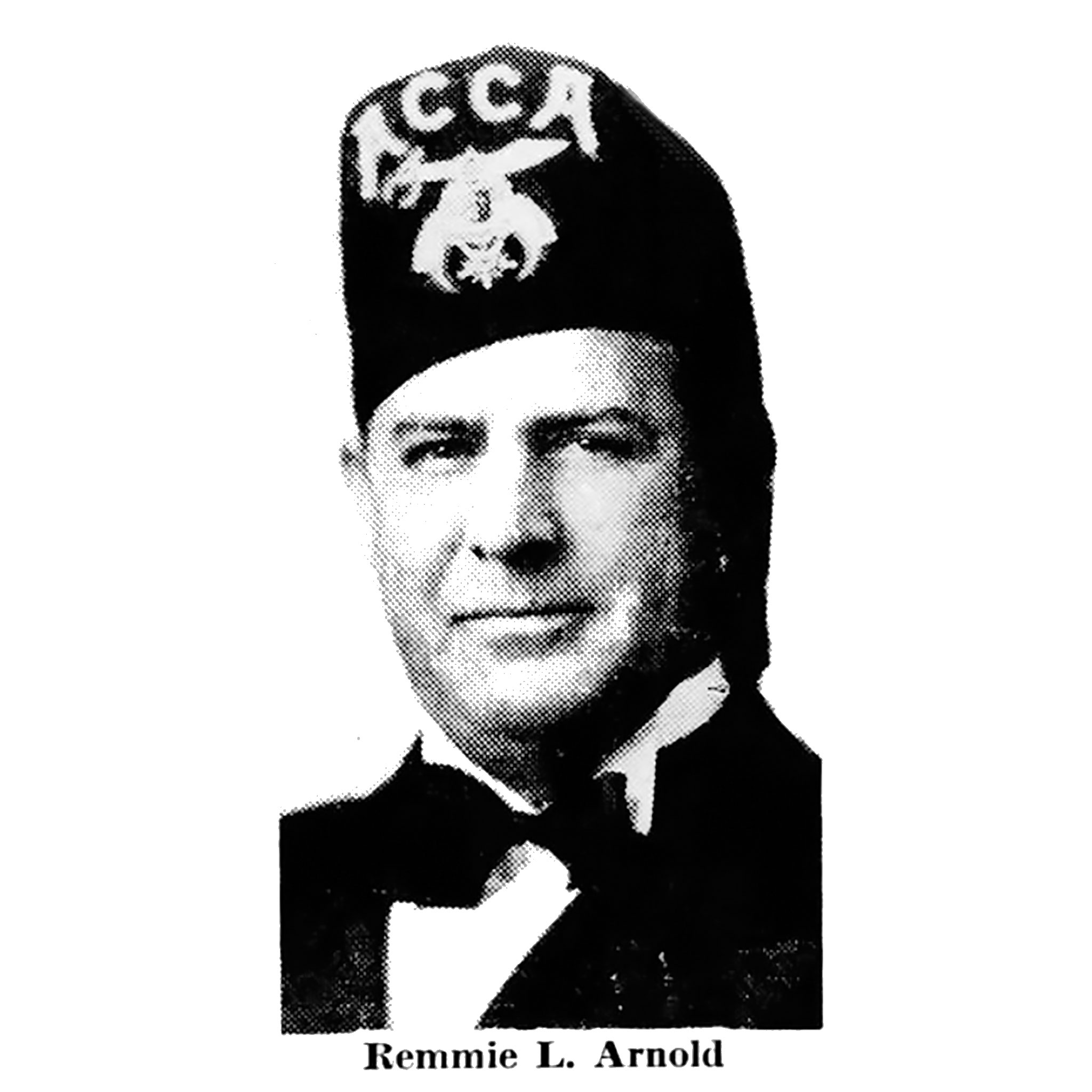 Remmie Arnold photo from 1941
Remmie Arnold photo from 1941
Meanwhile, the Arnold Pen Company successfully transitioned from making fountain pens to primarily ballpoint pens over the 1950s. As an example, in November, 1960, Arnold received an order from S. S. Kresge Company in Detroit, Michigan for 250,000 pen and pencil sets “for the Christmas season” and the customer wanted them in ten days. I think it’s most likely these were ballpoint pen and pencil sets.
By 1961, the company was looking for more manufacturing space because the East Washington street building lost 15,000 square feet of usable space due to a fire in 1958. Arnold purchased the larger Armstrong building about a half mile away at 142 Union Street, but orders in hand were too strong, with a thirty day backlog, to make the move in 1961, so he delayed it until 1962. Although both buildings had 40,000 square feet of usable space, the effective usable space of the East Washington building had been reduced to only about 25,000 square feet. At the time, the company employed about two hundred workers and was running at four times the previous year’s production, “in excess of 50,000 pens per day.” Arnold still claimed to be the world’s second largest pen manufacturer by volume, selling to a variety of retail outlets including “mail order houses, supermarkets, variety and drug stores, … premium users” and for “advertising purposes,” likely corporate imprint products.
Arnold sold Chester Plantation in 1961 and moved to a nearly 4,000 square foot ranch style house he built at 12 Saddleback Lane, in Petersburg, Virginia, less than two miles from the factory. Blain B. and Louise F. Baugus bought Chester Plantation and in 1963, they opened an 18-hole golf course on the property, known as the Arnolda Ranch Country Club, later on it was changed to Prince George County Golf Course and the house became the clubhouse and a restaurant. It was listed on the National Register of Historic Places on November 3, 2007. Today the 8,500 square foot house, a 48 acre estate, and the original ten acre lake are owned by Chester Estates Inn and Events, which operates it as a bed and breakfast.
 Arnold pen/pencil combo in a spiral wrap cream and black marbled celluloid c. 1935-1939
Arnold pen/pencil combo in a spiral wrap cream and black marbled celluloid c. 1935-1939
The factory move finally happened starting in January of 1962 and was completed in five months by June. The company claimed that only a half hour of production was lost, due to moving employees from the old factory. The first half of the year was chosen as it was a slower sales period. All the equipment and machines were moved in “a pickup truck and two station wagons” with Remmie Arnold and his son personally doing the work. They did hire help to move four safes. Arnold and his son designed the new production layout, and personally installed the pipes and conveyor system, which ran the length of the building, and the equipment shelves. By 1962, Arnold was manufacturing about 1.5 million fountain pens and 20 million ballpoint pens per year. The shift to low cost, low margin ballpoint pens was already underway, and fountain pens would be dropped probably by the mid 1960s.
Remmie Arnold died at 77 on June 23, 1971 at Petersburg General Hospital. At the time he was still living at 12 Saddleback Lane. The house, like Chester Plantation, still exists today. His son, Remmie Arnold, Jr., succeeded him as president of the Arnold Pen Company. Remmie Arnold, Jr. died at age 65 on November 18, 1985, and the company’s ownership passed to his wife. Their son, Remmie Arnold III then took control, but only for a few years. The company was by this time focused primarily on very low cost and margin stick and retracting ballpoint pens.
A New and Final Chapter
The Arnold Pen Company was sold on November 20, 1987 to a group of buyers with Chris Shepherd as president, holding a controlling 75 percent interest. In an interview in 1992, Shepherd, described as a "39-year-old former political consultant and a marketing whiz," told how the company had been through difficult times before the sale. Sales in 1982 were $1.2 million and for the next six years sales eroded about 10 percent a year. The company dwindled to only fourteen employees during the 1980s, before the sale to Shepherd’s group. After new management took over sales in 1988 were only about $500,000. New programs instituted increased sales to about $1.8 million by 1990 and by and by additional 33 percent to $2.5 million in 1991. By 1992 the company had grown to 42 full time employees making 500,000 pens a week, for an annual production of at least 25 million pens. The new owners did not advertise or have a sales organization, instead directly prospecting and working relationships with large reseller and promotional customers.
In 1992 the Arnold Pen Company was the only pen manufacturer left in Virginia, making stick and retractable ballpoint pens. They differentiated with added capabilities to customize with silkscreen imprints and applied patterns, including holographs. Arnold saw their competition now as BIC, Paper Mate, Scripto, Pilot and Faber Castell, but primarily Scripto, who competed with Arnold for packs of inexpensive stick ballpoint pens at retailers like Kmart, Wal-Mart, McCrory, G. C. Murphy, Rite Aid, and Raymond Geddes. Arnold was the smallest company in that market and competed by adding value with their customizing ability, making many colorful decorated products designed to appeal to young buyers. The other large source of business was in the specialty market, focused on company imprints, advertising, and giveaways.
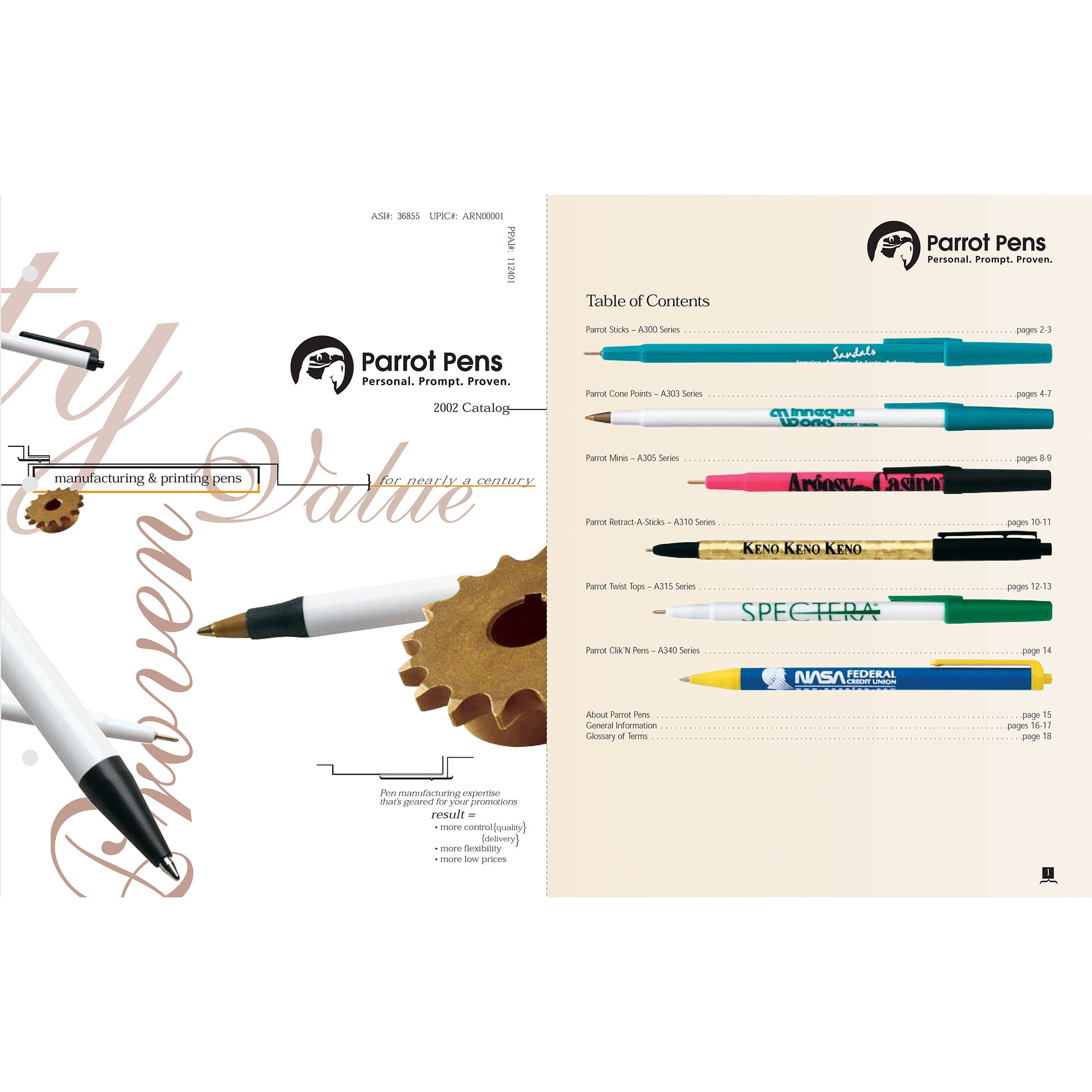 Parrot Pens 2002 Catalog, cover and page 1
Parrot Pens 2002 Catalog, cover and page 1
The company was still in business in the 2000s, though barely making any news. A search using the Wayback Machine shows a very simplistic company website active from 2002 to 2010 with Chris Shepherd still listed as president as of 2002. The eighteen page 2002 company catalog shows a change in the product brand name to Parrot Pens and offering six lines, all shown with sample company logos and imprints.
Probably the last public highlight for the Arnold Pen Company was in 2007 when the company received an urgent order from Virginia Tech for 5,000 orange and maroon pens. Each was imprinted with the school’s Thomas E. Cook Counseling Center contact number and were to be distributed at a memorial service for the victims of the shootings that took place on campus April 16, 2007. The order came in at 10 am on Thursday, April 20, 2007 and were needed in Blacksburg by 10:30 am the next day. Such a job would normally have a ten day turnaround, but Arnold completed production the same day and overnighted them to the school, over 200 miles away.
The Arnold Pen Company was listed in 2009 as a member of the Petersburg Chamber of Commerce. By 2010 it the company rebranded itself as Parrot Pens, with a parrotpen.com website and a new corporate parrot logo, dropping Arnold, though the arnoldpen.com website was still active at that time. That appears to be the last year the company was in operation and its final address was 15 North Union Street in Petersburg. I wonder what Remmie Arnold would have thought of his company's final legacy represented with a parrot logo.
Let’s Talk About Early Arnolds
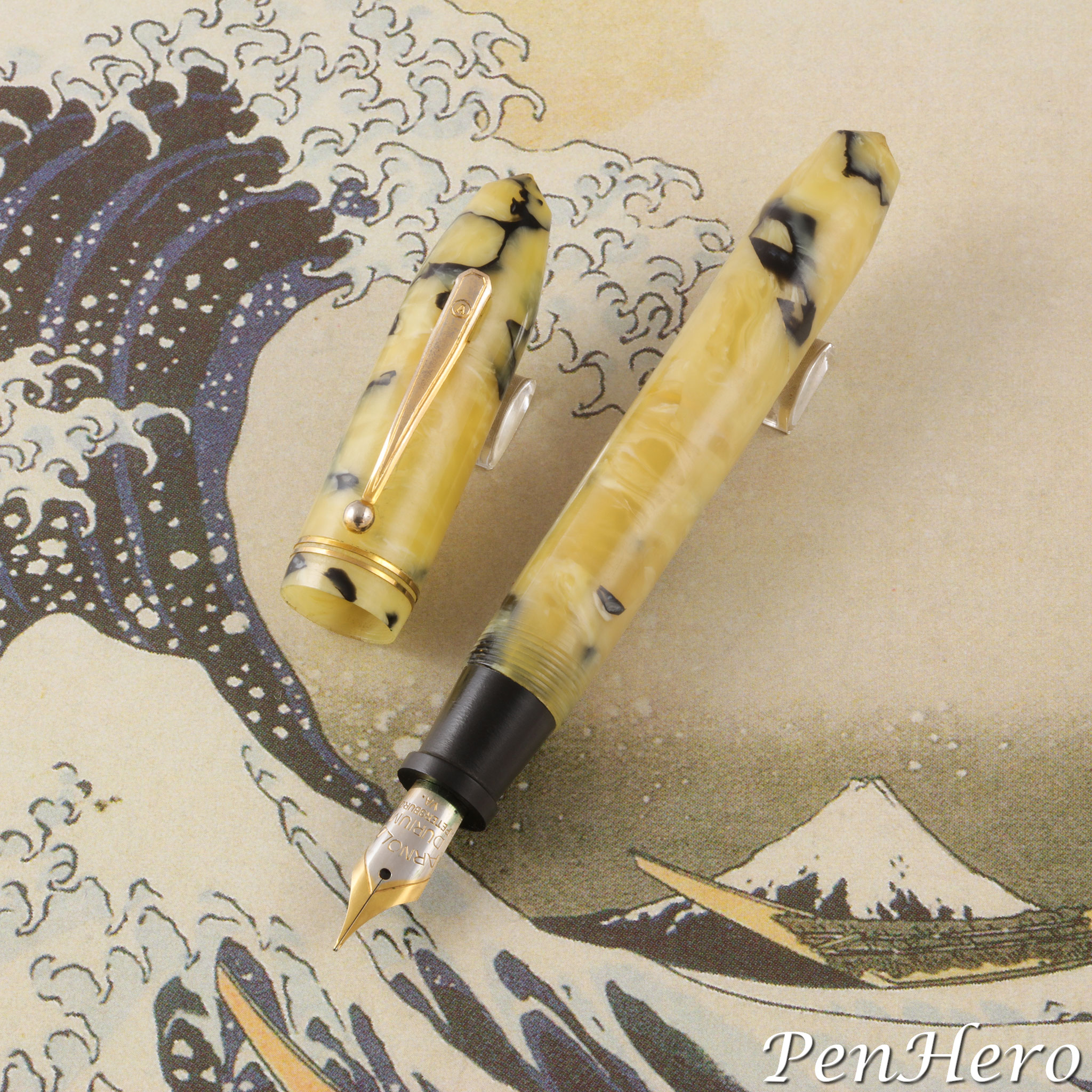 Arnold Jumbo fountain pen in cream and black marbled celluloid c. 1935-1939
Arnold Jumbo fountain pen in cream and black marbled celluloid c. 1935-1939
What were the earliest Arnold Pens? There are almost no company documents from the early years of 1935-1940 that would describe the variety of Arnold fountain pens, pencils, and pen/pencil combos, but there are a lot of obviously 1930s style Arnold pens in circulation. From 1935 to 1941, Arnold primarily made cheap celluloid fountain pens with steel nibs and very light gold plating to be sold by the gross to larger retail chains that wanted low cost budget pens and pen sets and would buy in very large volume. Arnold was a cheap pen making machine. Based on the Arnold pens I've seen, many of these early pens were balance shaped, many with tapered and pointed ends. In 1937 and 1938, if not earlier and later, Arnold was also making "midget" fountain pens and pen/pencil combos, with one described as the #ST4 "essence of pearl midget combination." A review of the very few advertisements that describe any Arnold pens does reveal a shift to military clip style pens about 1941, which would possibly mean an end to or decline in making balance shaped pens. For this article, I’m going to focus on a selection of the better quality Arnold pens made from about 1935 to 1939 rather than the obvious cheapies they also made by the bucket full.
Jumbo!
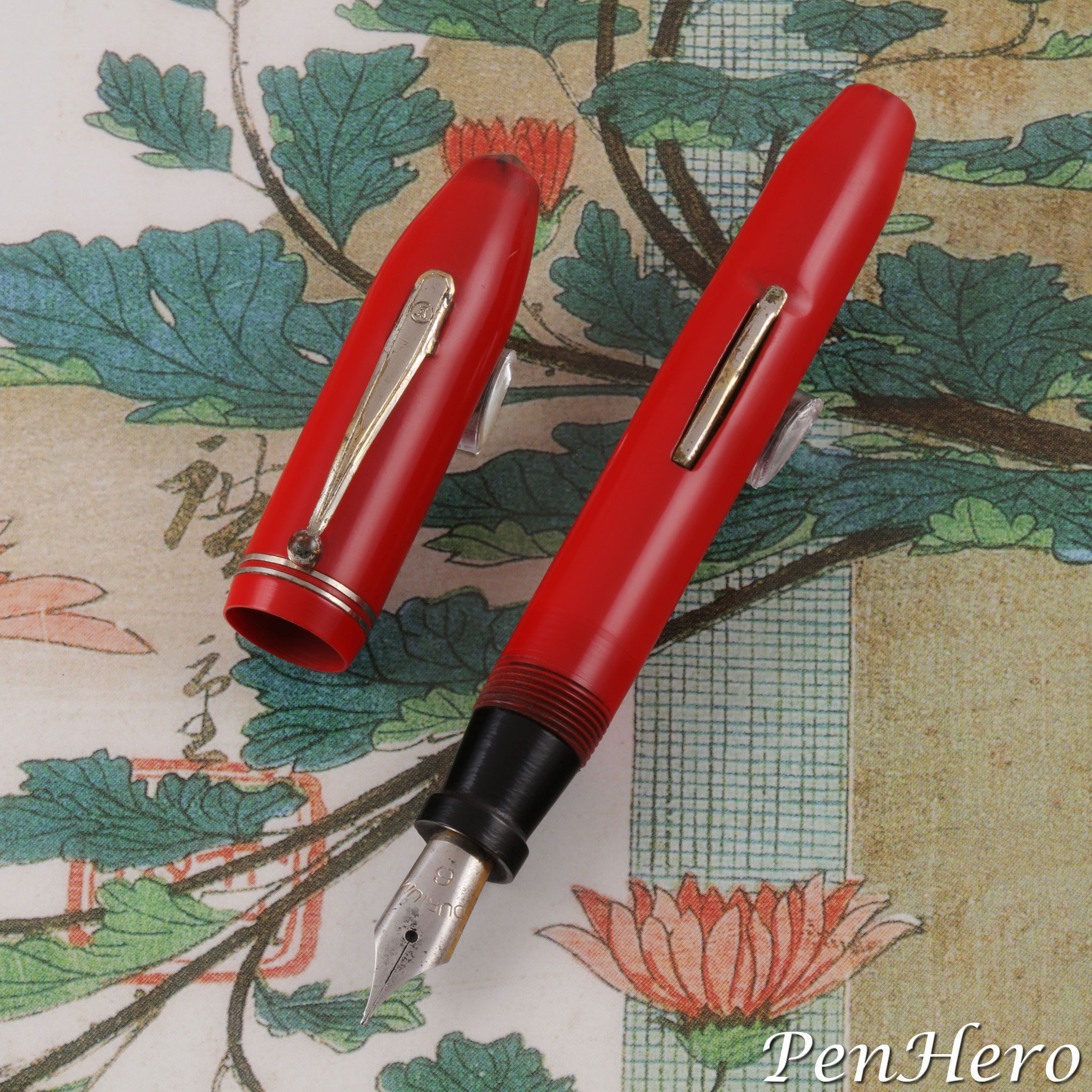 Arnold Jumbo fountain pen in red c. 1938-1939
Arnold Jumbo fountain pen in red c. 1938-1939
I can’t really do a full identification guide without catalogs or price lists. Arnold doesn't have much of a collector focus and they sold their super inexpensive products by the gross. The ownership group that took over Arnold in 1987 bought a company in decline that was long removed from the early fountain pens and pencils. I would imagine any early company documents, including catalogs and price lists, were long gone by that time. As a result, there isn't much primary company information available.
I did find a January 19, 1938 sales letter headlined “We Present Our First 1938 Value.” In it, H. A. Burke, an Assistant Sales Manager, offers a sample of a new offer, the B41 Extruded Jumbo Pen, with 14 karat gold plated nib and trim with a large, "#6 Durium Point" in plain extruded plastic colors, including Red, Blue, Black, Green, and White for $17.20 per gross, or 11.875 cents each. What kind of plastic it was is not known. At that cost, the pens could be sold for less than 25 cents each and get better than a 50 percent gross margin. That would get the attention of any buyer for a retail chain.
I believe the solid color pens shown here are B41 Extruded Jumbo Pens. They are wide bodied, ½ inch across, chunky pens, roughly balance shaped with tapered cap and barrel ends topped out to a sharp point. The design for these pens includes a ball end clip with an ‘A’ in a circle stamped on the top face and two slim cap bands. Arnold also made marbled versions of this pen, though I don’t know if they are earlier, later, or both. A slender version was also made using the same basic design and which appears as part of the header for the above letter to retailers. A fountain pen/pencil combo was also made in a variety of marbled celluloids. I have not seen one in solid color plastic, but that does not mean they were not made. Some pens have clips without the Arnold 'A' in a circle, and/or different cap bands, but they are clearly the same design.
- Cap and barrel made either of solid color extruded plastic in Red, Blue, Black, Green, and White or a variety of marbled celluloids
- Black plastic nib section
- Gold plated ball end clip stamped ‘A’ in a circle near the top
- Gold plated side lever
- Lever filler
- Threaded cap
- Gold plated stainless steel nib stamped DURIUM over 6
- Nib grades unknown, medium and fine observed
- About 5 1/4 inches long capped and 6 3/8 inches posted
- Retail price for the fountain pen unknown
- Pen packaging unknown
- Matching pencil unknown
Performance
I have several Jumbo size Arnold pens in solid and marbled colors, so I selected the one with the best nib for a test run. This solid blue Jumbo is about 5 1/4 inches long capped and 6 3/8 inches posted. It's quite light and very chunky looking. It can be used easily without posting the cap on the end of the barrel. Posting the cap does not feel completely secure, so I left the cap off for the writing test.
It fills like any other lever filler. Dip the nib in ink, pull the lever, count to twenty, wipe the nib and section, and it’s ready to write. The big gold plated stainless steel “DURIUM 6” nib writes like a firm fine with a little whistling in some strokes. It’s a pretty smooth writer otherwise, and I can imagine the original owner not being disappointed with the pen. A little tweaking and this could be a daily writer. It’s bigger in the hand than I expected, like a large kid’s crayon, but not uncomfortable to write with. The cap definitely does not need to be posted.
 Arnold Jumbo fountain pen in blue c. 1935-1939
Arnold Jumbo fountain pen in blue c. 1935-1939
In general, Arnold pens are overlooked and with good reason. Most of them are junky and did not hold up well over the years. They were not made with a lifetime warranty or lifetime use in mind. Some Arnold pens were made using attractive celluloids and designs, and those are the ones to look for. A case could be made that certain Arnold pens, like these Jumbo pens and their kin, would make an interesting collection. Acquiring nice examples will take some patience as they are uncommon. The most likely problems will be bad nibs, plating loss, and loose fitting parts. Think about getting donor pens to rob parts from, if you really want to collect Arnolds. They are easy enough to repair and Arnolds are often used as pens to practice on. Hey, I only broke an Arnold! Nice Arnolds, if that can even be said, won’t cost much unless they have been repaired, and even then, will not be expensive. Imagine a collection of nice Arnolds! I wish there was more information on the company’s products. There are a few other interesting Arnold models that will make up a future article!
References
“5 Manufacturers Here Get Boosted Quotas” Richmond Times-Dispatch, Richmond, Virginia, October 10, 1944, page 18
“Acca Temple Names Arnold Of Petersburg as Potentate” Richmond Times-Dispatch, Richmond, Virginia, January 22, 1941, page 6
Arnold Trademark, Official Gazette of the United States Patent Office, November 18, 1941, page 546
“Arnold Co. Delays Move; Business Is Too Good” The Progress-Index, Petersburg, Virginia, September 1, 1961, page 9
“Arnold Moves to New Plant, Loses Only ½ Hour Production” The Progress-Index, Petersburg, Virginia, July 1, 1962, page 15
“Arnold Pen Co. rushes order to help Virginia Tech students” by Julie Buchman, The Progress-Index, Petersburg, Virginia, April 20, 2007, page A1
“Arnold to Make Pencils, Pens Only at Petersburg” The Richmond Times-Dispatch, Richmond, Virginia, August 11, 1935, page 4
“Businesses care, too” Richmond Times-Dispatch, Richmond, Virginia, April 20, 2007, page A6
“Charters Issued” Richmond Times-Dispatch, Richmond, Virginia, February 4, 1913, page 7
Chester Estates Inn and Events
Chester Plantation Draft Nomination for National Register of Historic Places hand dated, December 4, 2002
Chester Plantation, Prince George (County) The Virginia Department of Historic Resources
“Death Notices: Arnold” The Richmond Times-Dispatch, Richmond, Virginia, June 24, 1971, page B-2
“Fire Does Damage” The Richmond Times-Dispatch, November 8, 1929, page 21
“Former Petersburg Major Arnold dies” The Richmond Times-Dispatch, Richmond, Virginia, November 20, 1985, page 18
“Granted Charter” The Richmond News Leader, Richmond, Virginia, August 8, 1935, page 24
“In Pen Business” The Richmond News Leader, Richmond, Virginia, August 10, 1935, page 14
“It’s Just Cooperation” The Progress-Index, Petersburg, Virginia, November 9, 1960, page 17
“Leroy Arnold Announces For Governor Race” Daily Press, Newport News, Virginia, November 21, 1948, page 1 and 8A
Parrot Pens 2002 Catalog
“Pen Factory Starts” The Richmond Times-Dispatch, Richmond, Virginia, August 19, 1935, page 9
“Pen Manufacturer Remmie L. Arnold Dies At 77” Daily Press, Newport News, Virginia, June 25, 1971, page 6
“Petersburg Pen Factory Opened” The Richmond News Leader, Richmond, Virginia, August 19, 1935, page 16
“Petersburg Pen Manufacturer In Losing Battel With WPB” by Overton Jones, The Richmond Times-Dispatch, Richmond Times-Dispatch, Richmond, Virginia, May 6, 1942, page 5
Petersburg, Virginia, City Directory, 1915, page 148, 1916 page 178, 1918 page 186
“Remmie Arnold Is ‘Horatio Alger’ Candidate for Governorship” by Ernest C. Pollard, The Virginia Gazette, Williamsburg, Virginia, July 15, 1949, page 11
“Remmie L. Arnold Sr., 77, Succumbs in Petersburg” The Richmond Times-Dispatch, Richmond, Virginia, June 24, 1971, page B-2
“R. L. Arnold Dies at 77; Sought Governorship” The World-News, Roanoke, Virginia, June 24, 1971, page 4
“Shriner Likes Tour” The Richmond Times-Dispatch, Richmond, Virginia, June 15, 1971, page 3-B
“The Candidates: Arnold Had Alger Hero Career” by Ernest C. Pollard, The Richmond Times-Dispatch, Richmond, Virginia, June 5, 1949, page 1
“The Petersburg Chamber of Commerce Thanks Our 2009 Members” The Progress-Index, Petersburg, Virginia, December 29, 2009, page A11
“The Write Stuff” by Tom Kazas, The Richmond Times-Dispatch, Richmond, Virginia, April 20, 1992, pages B-1, B-16-B-18
“We Present Our First 1938 Value” R. L. Arnold Pen Company, January 19, 1938
arnoldpen.com Wayback Machine capture
Interact
Comments on this article may be sent to the author, Jim Mamoulides


